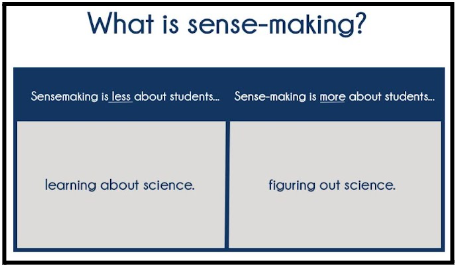Student Sensemaking | Bite
This unit is part of Dig Into Science learning modules, part of the ACESSE project. Dig into Science is designed to introduce teachers, paraprofessionals, principals, or anyone else to current science education, often called “three dimensional” science education.

Bite (1 minute learning experience)
What is Sensemaking?
When students as scientists have authentic, relevant opportunities to actively make sense of the world (Phenomena) and beyond- what we call sensemaking - science learning becomes engaging, accessible, and important to ALL students.
Sensemaking is actively trying to figure out a phenomenon or how to design solutions to problems.

Why should I have students engage in sensemaking?
Sensemaking allows students to surface prior knowledge, lived experiences, and misconceptions about a scientific idea. Teachers use sensemaking to honor prior knowledge and to bring authenticity and richness to the class discussion. Instead of correcting misconceptions, teachers facilitate activities to guide students to the currently recognized scientific ideas. While this process is not efficient, it is far more effective for the long-term retention of knowledge, supports students of many different backgrounds, and enables use of the science and engineering practices. (Cannady, et al, 2019)
Hear from a teacher and their students explain why sensemaking is important in the science classroom.
Reflection Question
What learning situations in your own life benefitted from sensemaking as opposed to memorization or lectures?


